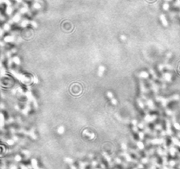|

|
Microbes
and Genetic Engineering
|
Genetic
researchers have investigated gene structure for many
years and know exactly the sequence of animal, plant, and
bacterial genes, and the regions which allow the
gene
to be expressed. Genetic engineering allows one to
actually change the sequence of the DNA at these
important regions to allow a human gene for example to be
expressed by bacteria. One can get this gene into the
chromosome
of a bacterium.
Then, this human gene will be expressed in a bacterium,
and a human protein can be made. This protein can then be
produced in great quantity, isolated, purified, and given
to people who need it.
This process has taken almost
30 years to be refined and continues to develop. A
historical timeline appears below. Feel free to follow
the links for more detailed information.
|
LINKS
|
DESCRIPTION
|

|
Examine the early
stages of genetic engineering, including early
discoveries made with bacteria, and the
scientists who made the
discoveries.
|

|
Learn about the
first major companies who made genetic
engineering an industry.
|
|

|
Discover the current
trends and future of genetic engineering. Are
there limits to what can be done?
|
TOP OF PAGE
BACK TO
MAIN PAGE
© 2000
Jody Becker, Robin Norwood and Brad Greenspan. All Rights
Reserved, except for the images, which retain their own
copyrights.
This site was designed by Jody Becker, Robin Norwood and
Brad Greenspan for MBI 699.W in August of 2000.
|